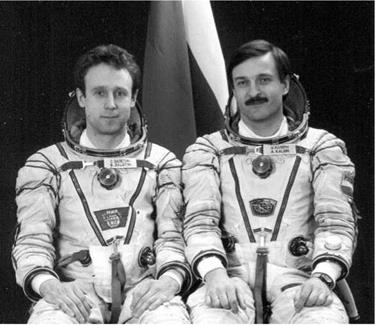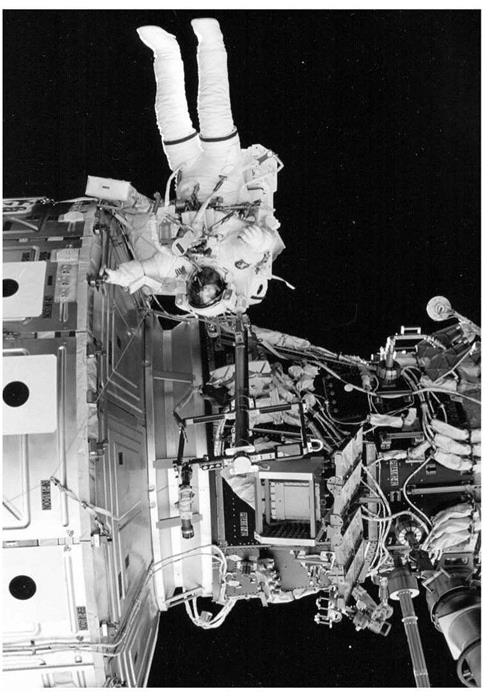. SOYUZ TM30
Flight Crew
ZALETIN, Sergei Viktorovich, 37, Russian Air Force, commander KALERI, Aleksandr Yuriyevich, civilian, flight engineer, 3rd mission Previous missions: Soyuz 14 (1992); Soyuz TM24 (1996)
Flight Log
After months of uncertainty, the funding for a new expedition to the Mir complex, the 29th, came from a new private corporation based in Amsterdam in the Netherlands. MirCorp was 60 per cent owned by RKK Energiya and shared with the venture capital group Gold and Appel and other entrepreneurs. The crew assigned to return to Mir were authorised by the Russian government to complete their mission, which included two new Progress cargo craft and a programme that could have extended into August 2000, a 70- to 90-day mission. MirCorp had also indicated that they had received authorisation from Energiya to lease Mir for space tourism, in-orbit advertising, industrial production and science, turning the station into a commercial space facility. NASA, quite understandably, was not happy about this sequence of events.
Soyuz TM30 launched from Baikonur on 4 April and docked with the station two days later. After a check of onboard systems and hatch integrity, the two cosmonauts opened the hatches and floated into the station, occupying it for the first time in eight months. For most of the first two weeks, the cosmonauts were occupied with housekeeping and bringing the station back into operation. One of their primary objectives was to establish whether the aging station could support the plans that MirCorp was promoting. An EVA was completed on 12 May and lasted for 4 hours 52 minutes. This was to be the final excursion from the Mir complex. The crew performed a test of a sealing compound on the hull of the station, an operation that had been delayed from previous missions. They also inspected and detailed the condition of the station, dismantled experiments and retrieved sample cassettes.
|
|
The final Mir resident crew of Zaletin (left) and Kaleri was launched to the Station aboard Soyuz TM30
During their stay aboard Mir, the EO-28 crew was able to perform research in biomedicine, space sciences, materials sciences, Earth sciences and technology. While discussions went on about what mission would follow, the cosmonauts began to pack up their experiment results and prepare the station for a period of inactivity, as for only the fourth time in its history, it would be left without a crew. MirCorp had planned a period of inactivity after this flight to secure new funds and to plan future operations based on the reports and feedback from this recent mission. In the early hours of 16 June, the two cosmonauts undocked from Mir and prepared for their return journey, leaving Mir alone in orbit. The crew reported that the station was in good shape and that there seemed to be no reason why it could not be revisited again. Of course, the subject of raising the funds to support these revisits was not mentioned.
Delays in securing the funding resulted in launch schedule slippage. The first space tourist was announced as American Dennis Tito, who scheduled to visit the station in 2000. This slipped to 2001 and funding from MirCorp was not forthcoming. Energiya now looked to de-orbit the station in the spring of 2001 and a new Progress was launched to direct the station to a fiery re-entry. On 15 February 2001, the Mir base block celebrated its fifteenth year in space. To ensure it fell on unpopulated areas, the Progress engines were fired for 20 minutes on 23 March and again twice more on succeeding orbits. The station entered the atmosphere and burned up, with some of the larger items of debris falling into the Pacific some 3,000 km east of New Zealand. The final communique from the Russians was that “Mir ceased to exit.” It was time to
look towards ISS, but in the ten years between the arrival of the Soyuz TM8 crew on 7 September 1989 and the departure of the Soyuz TM29 crew on 27 August 1999, Mir had been occupied continuously for 3,640 days 22 hours 52 minutes, a record the ISS will not break until October 2010.
Milestones
216th manned space flight
89th Russian manned space flight
82nd manned Soyuz mission
29th manned Soyuz TM mission
28th and final Mir resident crew
35th Russian and 75th flight with EVA operations
1st mission funded under MirCorp

 |
Flight Crew
HALSELL Jr., James Donald, 43, USAF, commander, 5th mission Previous missions: STS-65 (1994); STS-74 (1995); STS-83 (1997); STS-94 (1997) HOROWITZ, Scott Jay, 43, USAF, pilot, 3rd mission Previous missions: STS-75 (1996); STS-82 (1997)
WEBER, Mary Ellen, 37, civilian, mission specialist 1, 2nd mission Previous mission: STS-70 (1995)
WILLIAMS, Jeffery Nels, 42, USA, mission specialist 2
VOSS, James Shelton, 51, US Army, mission specialist 3, 3rd mission
Previous missions: STS-44 (1991); STS-53 (1992); STS-69 (1995)
HELMS, Susan Jane, 42, USAF, mission specialist 4, 4th mission Previous missions: STS-54 (1993); STS-64 (1994); STS-78 (1996)
USACHEV, Yuri Vladimirovich, 42, civilian, Russian, mission specialist 5,
3rd mission
Previous missions: Soyuz TM18 (1994); Soyuz TM23 (1996)
Flight Log
The delays in preparing the Russian Service Module meant that it would not be launched until July 2000. This gave rise to maintenance concerns with Unity/Zarya, which by now had been in orbit for over 12 months. Specifically, there was concern about the shelf life and reliability of Zarya’s batteries, which had not been designed to provide power for so long without the addition of the Service Module’s power systems. A crew had been assigned to STS-101 (2A.2) and the mission was due to follow the launch and docking of the Service Module prior to arrival of the first resident crew. But with the delay, it was decided to split the STS-101 mission and original crew between two flights. The revised STS-101 mission (designated 2A.2a) would fly first in April 2000, and then after the docking of the Russian Service Module
|
Jeffery Williams hangs on to one of the newly installed handrails on the ISS PMA-2 during the 21 May EVA with James Voss |
the new mission, STS-106 (2A.2b), would complete the preparations for receiving the first resident crew.
The original crew for STA-101 was Halsell, Horowitz, Weber and Williams, plus Ed Lu and Russian cosmonauts Yuri Malenchenko and Boris Morukov. The two cosmonauts had trained extensively on SM systems and activation, including unloading the first Progress re-supply craft planned to dock to the SM shortly after it became part of the ISS. Lu and Malenchenko had also trained for an EVA together, so it seemed sensible to utilise this training to reassign them to the STS-106 mission after the launch of the SM and Progress. It was also decided that in order to further prepare the station by completing get-ahead tasks for the first resident crew, and to give the second resident crew experience aboard the station, the latter would fly to ISS aboard STS-101 as part of the Shuttle crew. This would also be of benefit in smoothing the hand-over operations between the first and second crew the following year. Therefore, Usachev, Voss and Helms found themselves visiting ISS a year earlier than planned.
The launch of STS-101 did not occur in April, thanks to three launch delays caused by high winds at KSC and the overseas emergency landing sites. The mission was designated a “home improvement house call” and after its eventual launch on 19 May, STS-101 docked with the station the following day. On 21 May, Williams (EV1) and Voss (EV2) performed the mission’s only EVA, of 6 hours 44 minutes, during which they secured the US-built crane and installed the final Strela units on PMA-1. After replacing a faulty communications antenna, they also installed handrails and a camera cable.
STS-101 remained docked to ISS for over 138 hours, with the hatches open for a total of 80 hours. During this time, the crew installed four new batteries and associated electronics in Zarya, as well as 10 new smoke detectors, four cooling fans, additional computer cables and a new communications memory unit and power distribution box for the US-built communications system. They also transferred over almost 1,500 kg of logistics into the Unity and Zarya modules, including clothing, tools, can openers, sewing kits, trash bags, a treadmill and exercise bicycle ergometer, an IMAX film camera and four 45-litre water containers for use by the resident crews. A further 590 kg of logistics was transferred the other way, back to Atlantis for return to Earth.
Prior to undocking, the orbit of ISS was boosted by a further 45 km by firing the onboard engines of Atlantis in three sessions. The new orbit was approximately 383 x 370 km. Once again, a fly-around of the station was performed after the orbiter undocked in order to photo-document the condition of the station.
Milestones
217th manned space flight 128th US manned space flight Shuttle mission 21st flight of Atlantis 3rd Shuttle ISS mission 1st Atlantis ISS mission












